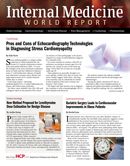Publication
Article
Internal Medicine World Report
Study Further Explores Costs Associated with Chronic Pain
Author(s):
From 2000 to 2007, medications to treat nonmalignant chronic pain (NMCP) came with a price tag of $17.8 billion annually in the US, a Journal of Managed Care & Specialty Pharmacy study found.

From 2000 to 2007, medications to treat nonmalignant chronic pain (NMCP) came with a price tag of $17.8 billion annually in the US, a Journal of Managed Care & Specialty Pharmacy study found.
While there has been previous research on the 100 million yearly patients afflicted with chronic pain, which accounted for 22% of primary care visits, investigators from the University of Missouri (MU) added to information involving NMCP patients’ prescription habits and outpatient visits.
From their wide-ranging analysis of 690 million chronic pain outpatients, researchers noted an increase in doctor chronic pain visits from 11 to 14%. Of the 113.8 million opioid or opioid-like prescriptions administered during the study’s scope, the total costs for pain medications were determined to be $142.4 billion, or $17.8 billion annually.
Specifically, the investigators noted analgesics/Non-Steroidal Anti-Inflammatory Drugs (NSAIDs), opioids, and adjuvants were the top 3 therapies used for chronic pain.
Among NSAIDs, which cost $1.9 billion annually, authors found celecoxib was one of the most expensive medications administered during the study’s observation period, accounting for 29.7 million prescriptions.
“The most prescribed opiate was hydrocodone/acetaminophen, with 39 million weighted prescriptions written from 2000 to 2007, contributing to the pain medications expenditures of $4.3 billion,” the writers detailed.
From their findings, the investigators hope highlighting prescription costs associated with NMCP will be of value to practitioners for individual and population-based care. With pain increasing, so that health care providers (HCPs) and health plan decision makers can consider allocating limited resources in the most efficient manner.
“These results can assist others in providing a baseline resource to further evaluate the costs and effectiveness of various therapies for pain management to assist in the development of effective pain management algorithms to diminish the public health burden of chronic pain,” the authors concluded.



